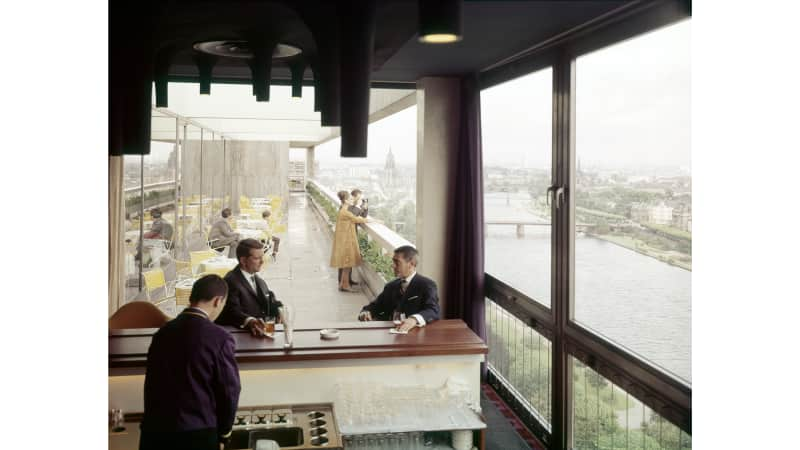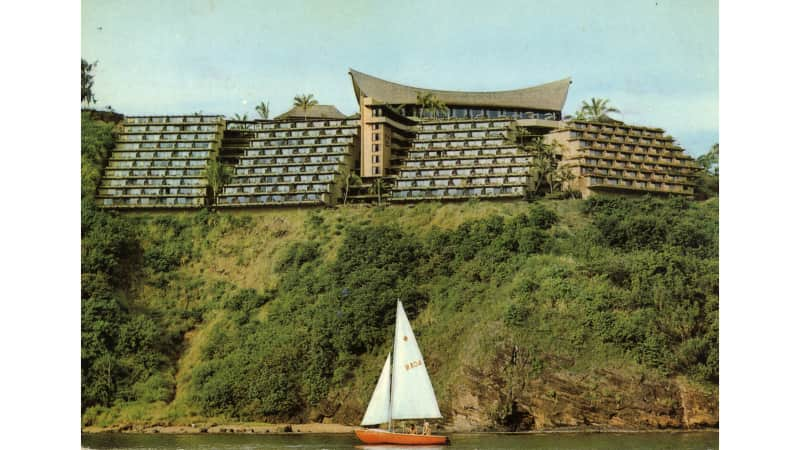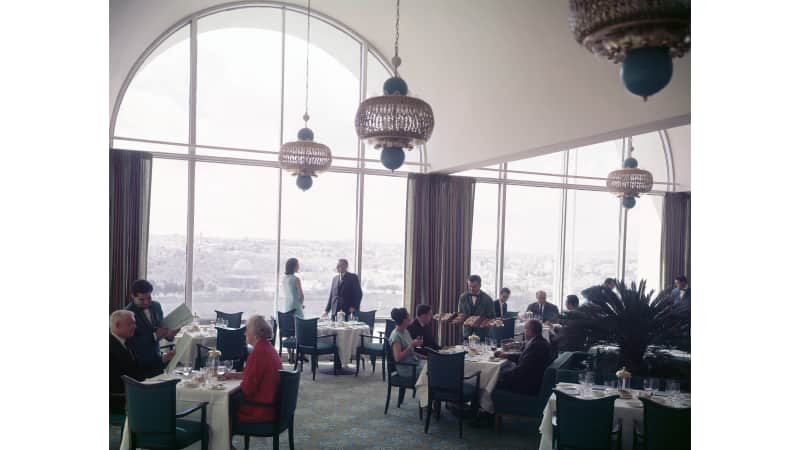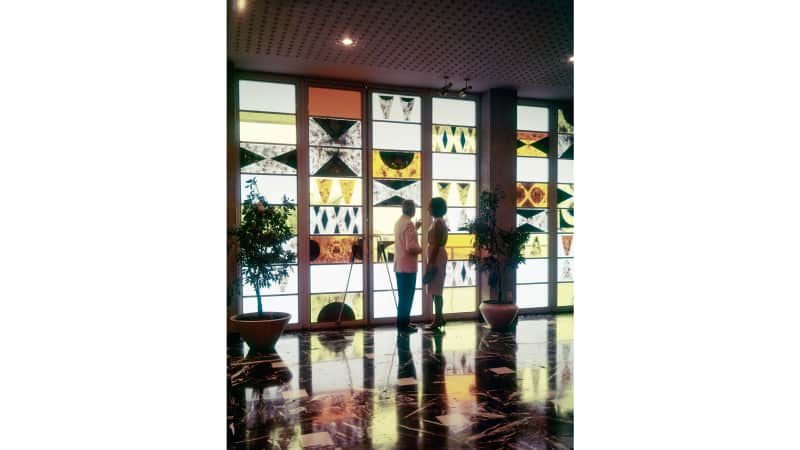(CNN) — Every time InterContinental Hotel interior designer Neal Prince stepped off a Pan Am aircraft in a new destination, he’d head straight to the city center for inspiration.
Prince would dip in and out of local galleries, stores and markets, befriending collectors and local artists, looking for objects, art and ideas to incorporate into that city’s InterContinental outpost.
Texas-born Prince was director of interior and graphic design at InterContinental from 1961 to 1985. Tasked with imagining interiors for more than 135 hotels across the globe, Prince wanted each hotel, in each destination, to feel specific, beautiful and evocative.
The InterContinental Hotel brand was established 75 years ago by Juan Trippe, founder of Pan American Airways, at the request of US President Franklin D. Roosevelt. In his book, Huhne explains that Roosevelt wanted to increase business with Latin American countries post-war, and business accommodation was needed.
Trippe, meanwhile, wanted to ensure that his air crews and passengers had a luxury hotel waiting for them wherever they went, especially as Pan Am introduced new destinations to its global flight schedule.
Local culture and American luxury

A bar with a view at the InterContinental in Frankfurt, Germany.
Courtesy of Arie deZanger
There was no universal blueprint for InterContinental Hotel interiors. Instead hotel rooms and bars would vary depending on their environs — and that’s where Neal Prince came in.
Prince’s rejection of hotel interior standardization was what made InterContinental stand out as the Jet Age took flight in the 1960s and ’70s, says Huhne.
“Neal Prince and his team found a way to combine local elements, and make it economical, and make it beautiful,” he says.
“When you woke up from a jet lag, you felt you were in Paris, or Geneva, or Brazil, or Colombia,” a representative of the Neal Prince Trust, which has kept the designer’s work alive since his death in 2017, tells CNN Travel. “That was his trademark.”
The hotel interiors combined local culture with American luxury. Prince is said to have drawn on his theater background to make hotel rooms look spectacular, without spending millions of dollars. Mirrors and carefully chosen paint colors were used to create space and depth.
These chic rooms were then splashed across magazines and travel brochures, enticing travelers to book a Pan Am ticket to somewhere exciting.

Photographer Arie deZanger captured the interior and exterior of this blue-tinged bedroom at the Tahara’a InterContinental in Tahiti.
Courtesy of Arie deZanger
Many of these marketing photos were shot by New York-based photographer Arie deZanger. A fashion photographer who’d captured top couture houses in Paris, Arie worked closely with his wife, Wilma, who’d studied fashion design.
Wilma tells CNN Travel she’d travel with her husband on his InterContinental assignments, coordinating productions, dressing sets, assisting with wardrobe, sourcing models, and occasionally standing in as a model herself.
Their work took them to destinations across the world for months at a time, from Monrovia to Bali. “We would photograph at least three different hotels while we were away,” Wilma says today.
Wilma calls Arie “an expert with lighting,” describing how he’d often aim to capture indoor and outdoor scenery, such as in a photograph of a bedroom in the Tahara’a InterContinental in Pape’éte, Tahiti, in French Polynesia, which highlights the rich blue furniture in the interior and the deep blue sky and ocean witnessed from the adjoining balcony.
The Tahara’a InterContinental, which opened in 1968, was built into the side of the cliff.
It was known as the “upside down” hotel, recalls Wilma, because of its unusual layout.

The Tahara’a InterContinental had its lobby and restaurants at the top of the building, while the bedrooms were built into the side of the cliff.
Courtesy of Arie deZanger
“When you walked into the hotel, you were going on the top of the cliff into the lobby and the restaurants and the bars and all of that, and then the hotel rooms went down the cliff,” she says.
Photographing the exterior of that hotel was a challenge for Arie, recalls Wilma. She describes how he shot the image from a small airplane with the door removed and no seatbelt.
Huhne says the Tahara’a InterContinental — which is now closed — “reflects the kind of romantic getaway hotel of the 1960s.”
The hotel had a striking swimming pool, almost an antecedent to the modern-day infinity pool, with its views of the ocean below, as well as an outdoor bar.
Huhne also notes that while Prince would use local artists and incorporate local culture into his interior design, his team would also reflect what Americans hoped to see on their vacations abroad.
“A time in history”

When needed, Wilma deZanger would step into her husband’s photos as a model. She’s the woman in blue in the background in this photo at this photo of the Hotel Jerusalem Intercontinental
Courtesy of Arie deZanger
Arie and Wilma deZanger would always arrive at an InterContinental hotel knowing what they wanted to capture in the photographs — “the luxury, the service, the atmosphere, the wonderful cuisine, the comfort,” as Wilma puts it.
She says she’d always marvel at Prince’s designs for each hotel: “His sense of color, his sense of the materials that were used, the choices were just amazing.”
After making a list of which scenes they wanted to capture, Arie and Wilma would figure out how many models they needed and then Wilma would start tracking people down — often Pan Am flight attendants and pilots would step in, she says, as well as hotel employees.
Wilma would tell the models how she wanted them to be dressed — poolwear, for example, or evening attire suitable for a dining scene — and get them to bring along four or five outfit options. An experienced food stylist, she’d also set up the catering shots.
For Wilma, the job was a joy, especially because it allowed the couple to travel extensively.
“I was always so intrigued with the cultures of countries, and people,” she says.
Looking back, Wilma reflects that the couple were working on the precipice of a new age in tourism.
“It was definitely a time in history — one of the points of changing — with tourism, with travel.”
Living in a hotel
For travelers, the InterContinental would be their first introduction, after the airport, to their vacation or business destination, and a home away from home for a while.
For former Pan Am flight attendant Alice Dear, one InterContinental hotel was her home for a whole year.
Dear started working for Pan Am following her graduation from Howard University in 1969.
“Others were going off to IBM or graduate school and doing what they considered to be more serious things,” she tells CNN Travel. “But I thought travel would broaden me in a way that nothing else would.”
When Dear started flying with Pan Am the summer of 1969, she was one of the airline’s first Black flight attendants and flew with the airline until 1977.
Over the course of her Pan Am career, Dear became a Purser, taught at the Pan Am training center in Miami and worked for a year in the Congo, then called Zaire, during which time she lived at the InterContinental Kinshasa.
Dear was based at the hotel with other Pan Am flight service specialists — they were training flight personnel on the Boeing 747 for Air Zaire, which was then managed by Pan Am.
“You had a large personnel group of expatriates who were living in the hotel at the time,” recalls Dear. “So the convenient part, of course, is that everything is done for us — it was a very nice hotel, and we had our meals there and developed a social life around interacting with the group from Pan Am.”
The group would hang out in the hotel, she says, and head to nightclubs.

Inside the Ducor InterContinental Hotel in Monrovia, Liberia.
Courtesy of Arie deZanger
The main disadvantage, says Dear, was a lack of privacy, and living out of a small room — plus a misunderstanding that once arose from the fact she and other Pan Am employees were young women living alone in a hotel.
“It was humorous, because it was so ridiculous, but it was also very insulting that we could not have our identity other than then we must be there as a prostitute,” she says.
During her time living at the InterContinental Kinshasa, Dear became interested in collecting local art. Her purchases soon lined the wall of her small hotel room and sparked a passion that continues to this day.
“Before, I had been more exposed to airport art, I’ll call it, as I traveled around. But while in Zaire, I was able to really begin to appreciate African art — and some of the richest art, I think, on the continent is found in that area,” she says.
As one of the first Black Pan Am flight attendants, Dear sometimes came face to face with racism.
She recalls often being the only Black flight attendant on a flight, and other White Pan Am flight attendants trying to avoid sharing a room with her at the InterContinental in Paris.
“If there was an odd number of flight attendants, if you’re last one you’d get a single room. So I wasn’t offended, I just hung back. And that’s how I got my single rooms in the Paris Intercontinental,” she says.
Later in her career, Dear became a banker and ambassador, appointed by President Bill Clinton, a role she says her Pan Am career prepared her for. Post Pan-Am, she continued to enjoy staying in InterContinental hotels on business trips.
InterContinental today
The InterContinental brand says its largely focused on the future, while still taking time to celebrate its long history as it turns 75.
Tom Roundtree, vice president for global luxury brands at InterContinental, says the brand continues to strive to find new destinations and new markets, as it did in the 20th century.
He adds that the “foundations” of InterContinental “remain the essence” of the brand today.
